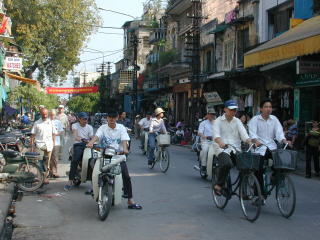
Wednesday, May 03-Sunday, May 7, Hanoi
My first impression of Hanoi is of a crowded city with narrow streets and life spilling out onto the sidewalks forcing everyone to walk in the streets contributing to the chaos of the traffic. To cross the street, you boldly step into the middle of the traffic and let it flow around you. Once when I was hesitating at the edge of the traffic, an old lady grabbed my arm and pulled me into the melee with her escorting me to the other side with a big grin on her face. My hotel is located in the old quarter. I expected it to be more gracious with the same boulevards as Saigon but more colonial. Most of the French colonial buildings I have seen are now ministers homes or government buildings.
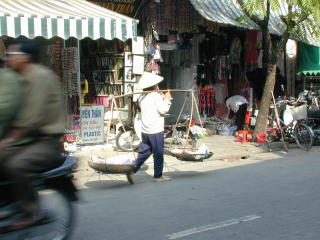
Notable by their absence are the American fast food chains. Vietnam has not yet succumbed to McDonalds, Burger King etc. 10 years ago, the only tourists were Russian. It wasn’t until after the self-imposed isolation was lifted with the Open Door policy in the late 1980’s and when Clinton lifted the embargo in 1993 that the rest of the world came back. First into town were Coca-Cola and Pepsi, of course. As tourism standards improve and word gets around, I am sure visitors will flood in.
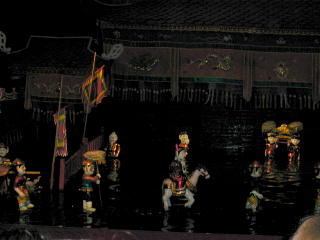
The villages around Hanoi are famous for their water puppet shows usually produced during festivals in the village lake. In Hanoi you can see them nightly. There are wonderful marionettes- dragons, ducks, people, boats etc who are controlled by a team of people waist deep in the water.
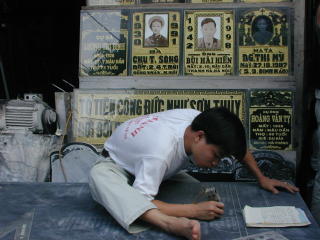
In the old quarter, every street is named after what it sells. There is a street with just shoes called Shoe Street, Paper Street, Silk Street etc. I even found a street which just sells plaques for tombs. I think they are the 2nd tombs which contain bones dug up after 3 years. Here a stone carver is chiseling someone’s picture into the stone.
I am constantly amazed by the artistic skill people have. And they are paid so little for it. Everyone from the girls in the villages who embroider to the stone or wood carvers. In the west, we are used to paying for original “handmade” items. Here it is almost like a factory. There is a fabulous museum here called the Vietnam Museum of Ethnology. It is a window on the different customs and lives of the 54 different ethnic groups of Vietnam. Each group has different skills and different patterns for clothes or ceremonies. Many of the clothes are wonderfully designed with bright colors and should be the inspiration for any of the famous designer collections.
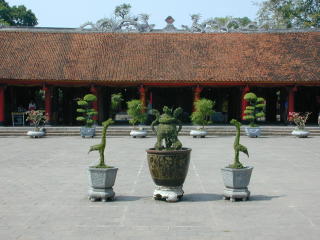
Many of the hill tribes and mountain villages have little access to clean water, health care etc. Their education is only rudimentary and yet they have these rich cultural lives. I also get the feeling that education is very highly valued in Vietnam. It has one of the highest literacy rates in the world – almost 90% – despite the fact that many children out of the big cities can’t go to secondary school. There are also a number of communities which live on the water and are difficult to keep track of due to their itinerant lifestyles. Some of the river families have 8-13 children due to lack of information about birth control. This is the Temple of Literature in Hanoi which was built in the 11th century as the first university.
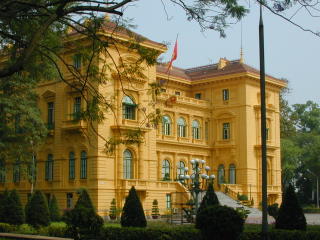
There are some wonderful old French colonial buildings in Hanoi. One of them which is carefully tended is the palace where Ho Chi Minh used to govern from.
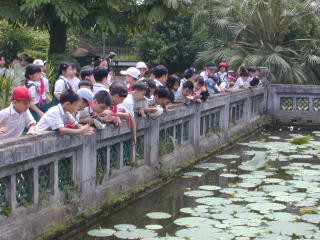
I have been quite impressed by what I have learned and seen of “Uncle Ho” as he is affectionately known. He seemed a genuinely simple and caring man but it’s difficult to tell. The Ho tour consists of seeing his embalmed body in a great marble mausoleum which the Russians helped them build (despite the fact that he asked to be cremated in his will), the presidential palace, a simple hut which is a copy of one in the hills where he actually slept and worked. Every year, poor Uncle Ho goes to Moscow for 3 months of “restoration” work. These children are entranced by the fish in a pond while on a field trip of his home.

In the center of town, there is a lake with a pagoda in the middle. Most people’s homes are very small and stuffy so they flock to the lakeside in the evenings to stroll, have a snack, whisper to their lovers, play Chinese chess. Chess involves the 2 players plus all their friends who have bet on the game. It becomes very noisy at times as each side taunts the other.
Also noisy are the loudspeakers in the streets every few lampposts which broadcast “news, current events and music” courtesy of the Communist Party. It is loud and unavoidable.
I love the way trash is collected here. Usually women on tricycles with big bins come by banging on a gong to notify everyone of their presence. People then bring their rubbish out and the women work their way up and down the narrow streets finally meeting up with a big trash truck at the edges of the neighborhood.
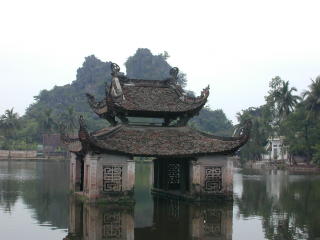
I visited the town, Thay about 30km from Hanoi, where water puppetry originated. It has a lovely lake and a series of pagodas and temples from the 11th century.
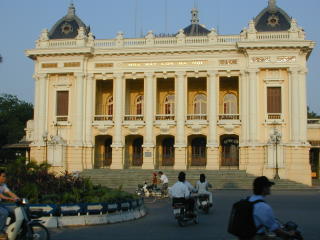
One afternoon I sat in the window of a French Pattiserie in front of the Hanoi Opera sipping a caf